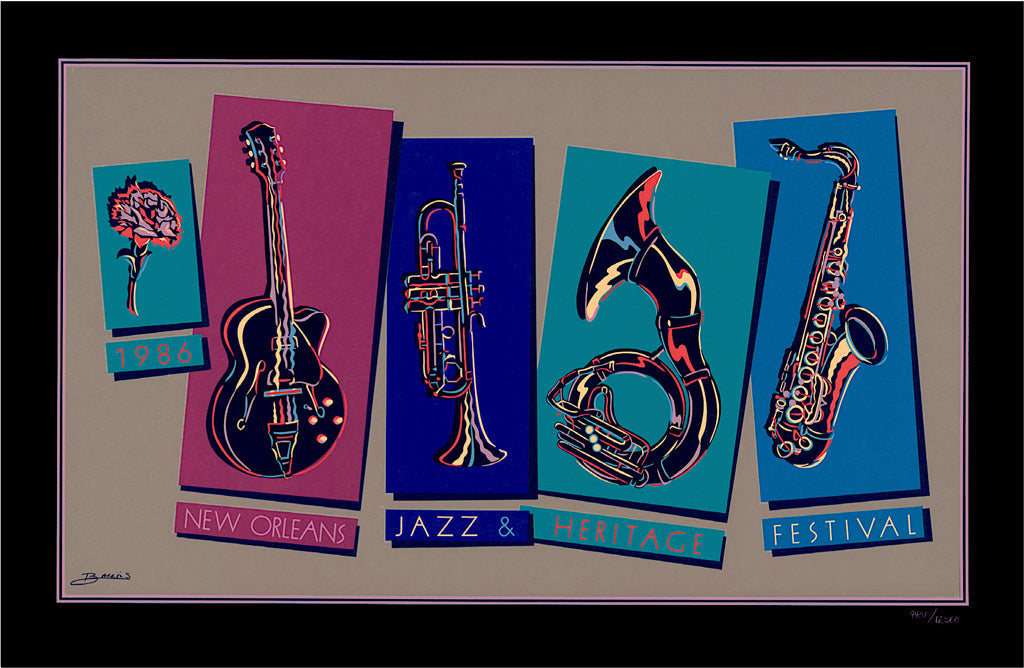The New York Times recently featured an article on Lyndon J. Barrois, Sr., who we had the pleasure of working with in 1986 when he was the artist for the Jazz Fest Poster. Click here to check PrintXChg, a resale platform, to see if any 1986 posters are available. Click here for the article or read below.
Sculpture Doesn’t Get Much Smaller Than This
Lyndon J. Barrois Sr., whose day job is high-tech animation, uses gum wrappers to create detailed portraits of historical figures and athletes in flight.
March 28, 2024 Text by Julia Carmel
Photographs and Video by Jessica Lehrman
Reporting from Los Angeles

At his day job, Lyndon J. Barrois Sr. uses high-tech software to create visual effects for movies like “Happy Feet” and “The Matrix: Revolutions.” But in his free time,he prefers working with a decidedly less sophisticated medium: discarded gum wrappers.
The wrappers are a nostalgic choice for Barrois, who started sculpting as an antsy 10-year-old with a Hot Wheels collection and a pet peeve. “You’d look in and see the steering wheel and the seats and like … where’s the driver?” he recalled, adding an emphatic expletive.
Barrois fidgeted with clay, aluminum foil, phone wires, even old chewing gum pulled from the bottom of church pews, twisting each material into tiny drivers for his cars. He soon expanded his repertoire to miniature athletes and finally landed on the perfect material in his mom’s Wrigley gum wrappers. “It was foil on one side, so I can sculpt it, and paper on the other side, so I can color it,” he said.

Barrois at his home studio in Los Angeles.
Nearly five decades later, he has made thousands of these one-inch-tall sculptures under the moniker It’s a Wrapper Studios. At 59, his techniques have gotten more refined, but he is still using the scraps of foil and paper to create portraits of iconic moments, such as Colin Kaepernick taking a knee or Kobe Bryant soaring through the air, which he brings to life using stop-motion animation. He does commissioned work for commercial agencies and editorial outlets, as well as his own personal projects.
“I love sports and dance, I just love the movement,” Barrois said. “To me they’re just pure forms of movement and emotion, you know winning and losing — everything is wrapped up in that.”
Barrois starts each sculpture by grabbing a gum wrapper from an Utz pretzel barrel in his studio; he brought thousands of wrappers with him from his family home in New Orleans when he moved to Los Angeles in 1992. “The way they make it now — depending on which brand you get — it doesn’t even hold a shape,” he said.
Barrois sculpts each figure out of a single wrapper, twisting and bending the paper without ripping it to form legs, a torso, arms and finally a neck. Football players get built-in shoulder pads and detachable helmets about the size of a ladybug. Basketball players are sculpted with taller, skinnier frames and bigger shoes.
Every portrait is heavily researched: Barrois studies an athlete’s knee injury or the way a certain basketball uniform drapes.

“It doesn’t matter if you’re painting on a canvas ... or if you’re doing something this small, because it’s portraiture, and it’s got to be accurate.”
Barrois breaks in the joints on each limb so the figures can be posed and adds a head before coating the whole thing in Elmer’s glue, to ensure the paper won’t unravel. He might fashion tiny accessories like jackets or eyeglasses. He then colors in each figure with watercolors, acrylic paint and ink. When all of the details feel just right, Barrois sprays the sculpture with a clear matte acrylic coat. If he’s animating the figure, he then sticks a small piece of wax on the bottom to hold it in place, positions it on a miniature football field or other “It doesn’t matter if you’re painting on a canvas ... or if you’re doing something this small, because it’s portraiture, and it’s got to be accurate.” custom-built set — green screening in different backgrounds when necessary — and uses an iPhone app called Stop Motion Studio to shoot about 30 frames for each second of motion. He adds faces for each sculpture later on his computer.

Barrois meticulously researches each portrait, such as this sculpture of the Kansas City Chiefs quarterback Patrick Mahomes.

He references photos, books and news coverage to learn about the specific person and moment he wants to capture.

Even in miniature, every detail must be correct.
Barrois didn’t always see his figures as art; they were a childhood hobby, something to keep his restless hands busy.

“To me they’re just pure forms of movement and emotion, you know winning and losing,” Barrois said. “Everything is wrapped up in that.”
But in the late 1980s, while studying graphic design at Xavier University in New Orleans, he was struggling with what to make for his senior art show. So he did what he so often did when he was frustrated: He grabbed some wrappers.Barrois crafted a tableau of the Pittsburgh Steelers playing the Washington Commanders (then called the Redskins) and brought it to school to show his professor, the sculptor John Scott.
“He was like ‘Dude, I don’t think you realize what you’re sitting on,’” Barrois recalled.

“I was like ‘What are you talking about?’ and he’s like, ‘This is sculpture.’”
Scott’s assessment proved correct. Barrois’s senior show, which recreated moments from the first 23 Super Bowls, was shown at the New Orleans gallery YAYA and featured on HBO Sports and “The Today Show.”
After getting his master’s degree in film and video from CalArts in 1995, Barrois’s professional focus shifted to animation. His projects range from “Scooby-Doo” to the 2011 remake of “The Thing,” and he joined the Academy of Motion Picture Arts and Sciences in 2019.But even with his success as an animator, Barrois always returns to his figures. His next project, “Groundbreakers,” will feature 800 portraits of Black people who have shaped American life, mounted on a pair of 58-inch shovels, which Barrois envisions as “standing history books.” Alongside icons like Barack Obama and Rosa Parks, he plans to showcase lesser known figures, such as the Detroit architect Helen Eugenia Parker.
“History is always recorded somewhere,” he said. “You just got to know how to dig deep enough to find it.” He feels a responsibility to continue carving out space for the wrappers. “My son, he told me years ago, ‘Dad, it’s cool you’re doing all these movies,’” Barrois said. “‘But you’re the only one on this planet doing this.’”
Julia Carmel is a native New Yorker who reports on nightlife, culture and queer communities.

